Miraculous defense of Jasna Góra? The steadfast prior of Kordecki? The vile traitor Janusz Radziwiłł? The image of the Swedish invasion, painted by Henryk Sienkiewicz in his novel, convinced not only laymen. Generations of researchers followed him. But where does historical truth end and fiction "to refresh hearts" begin?
Sienkiewicz's "Trilogy" is not a series of ordinary historical novels. Some of the most important Polish stories have something more to them. Their power was emphasized by Olgierd Górka, a historian and journalist, already in the interwar period:
The entire current generation of Poles looks at their past not through the results of scientific research, not through scientific treatises on the advantages and disadvantages of our military and politics, but through a brilliant suggestion of an unmatched novelist which alone had a stronger impact on the present Polish perception of its past than hundreds of volumes of scientific dissertations.
The writer Teodor Parnicki assessed the state of the historical knowledge of Poles in a similar way. The memory of all historical figures lives in minds and hearts in a way that is not imposed by historians, but by artists! - he was writing. In fact, it is difficult to compete with the power of the author's message with Ogniem i Mieczem or the Teutonic Knights. Especially that university historians, busy counting hens in noble's inventory, usually do not even try to give their works a literary touch. And then they are surprised that only their colleagues read them ...
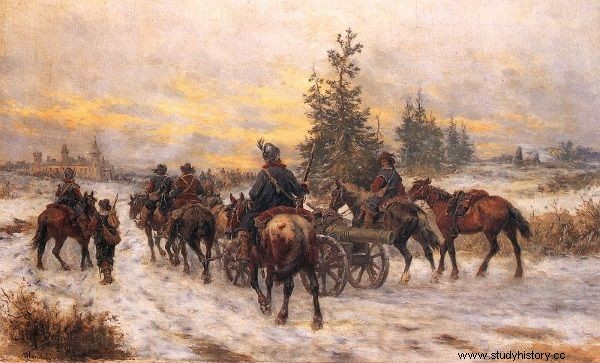
"Swedes going to Kiejdany" by Józef Brandt (public domain).
The phenomenon of the writer's encouraging Polish hearts, however, lies in the fact that his influence does not end with the readers who do not have much in common with history. The vision of the 17th century, created by Sienkiewicz, significantly influenced also researchers. Even they could not and are not able to free themselves from it. In many scientific books we read about the groundbreaking importance of defending Jasna Góra or about the treacherous prince Janusz Radziwille. Only is it right?
Did the defense of Jasna Góra really require a miracle?
According to today's researchers, it did not take a miracle to defend Jasna Góra against the Swedes. The monastery was well fortified and its defenders had excellent artillery.
Meanwhile, the besiegers who settled at its gates in mid-November 1655 looked threatening only on paper. Theoretically they were quite numerous, but in practice the commander of the Swedish forces, General Burchard Müller, had only a thousand men at his disposal.
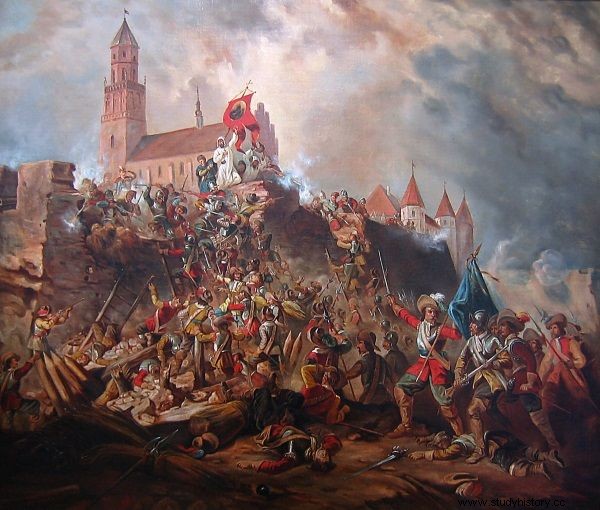
Artists like to imagine the siege of Jasna Góra in line with Sienkiewicz's vision. Well, the reality was a bit different than in the picture…
All because the Polish soldiers who swore loyalty to the Swedish king Charles Gustav did not want to besiege at all. In fact, they only passively assisted the Scandinavians. Historian Jacek Wijaczka also points out that Müller's army was not properly prepared for the siege:
( large cannons, gunpowder, and everything else you need to conquer strongholds. Gunpowder and bullets began to be scarce after the first day of shelling the monastery by cannons (...) brought on December 10 from Krakow (...). The shelling after December 11 clearly weakened, and soon it stopped completely .The Swedes besieged Jasna Góra until December 27. With such deplorable equipment and personnel, it is surprising that they lasted so long ...
Augustyn Kordecki - not so steadfast
When Sienkiewicz wrote "The Deluge", prior Augustyn Kordecki of Jasna Góra was considered an example of boundless patriotism. However, at the beginning of the 20th century, the Swedish archivist Theodor Westrin found two letters from the friar that put him in a different light.
Well, in October 1655 (so before the siege of the monastery began) Augustyn Kordecki gave himself up with the Paulines at Jasna Góra ... under the protection of Charles Gustav, King of Sweden! The discovery aroused mixed feelings among Polish connoisseurs of the era. This is how Wijaczek describes their reaction:
The Polish scientific community was reluctant to the Swedish historian's publications, accusing him first of forging documents and, if they turned out to be true, of misinterpreting them.
Writing about the historical awareness of Poles, the researcher also draws attention to the fact that Westrin's publication was discussed only among historians and journalists.
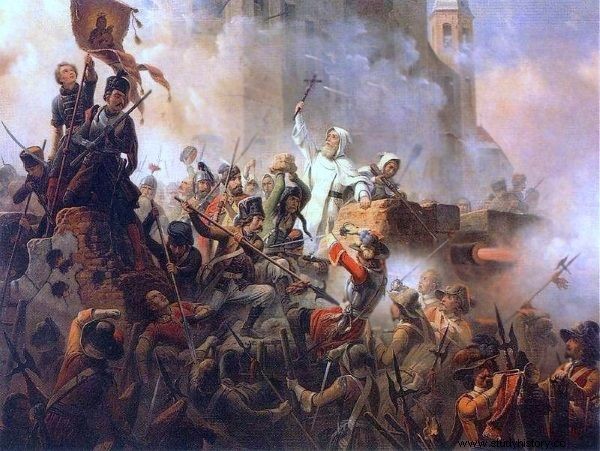
The heroic prior in fact gave Jasna Góra under the protection of Karol Gustaw.
It remained virtually unknown to the general public of Polish society. It did not harm Prior Kordecki, who in the common opinion remained a model of bravery and loyalty of the Republic of Poland - Wijaczek concludes.
Janusz Radziwiłł - not necessarily a traitor
In the historical memory of Poles, the great Lithuanian hetman Janusz Radziwiłł functions as an exemplary example of a traitor to the national interest. Meanwhile, it is possible that he just… died at the wrong time. When he died, on the night of December 30-31, 1655, the fate of the Commonwealth was still in balance. Many magnates and nobles still, like him, stayed in the Swedish camp at the time. For example, Jan Sobieski, the future king! They apologized to King Jan Kazimierz only after the economic change. Perhaps Radziwiłł would have reacted in the same way?
Under the influence of Sienkiewicz's novel (and Hoffman's film), the circumstances of Radziwiłł's decision in 1655 to surrender to the Swedish king Charles Gustav are also forgotten. Meanwhile when the Swedes entered the Grand Hetman of Lithuania, he had been facing attacks by the Moscow troops for a year. In August 1655, the Russians entered Vilnius and burnt the capital of the Grand Duchy of Lithuania ...
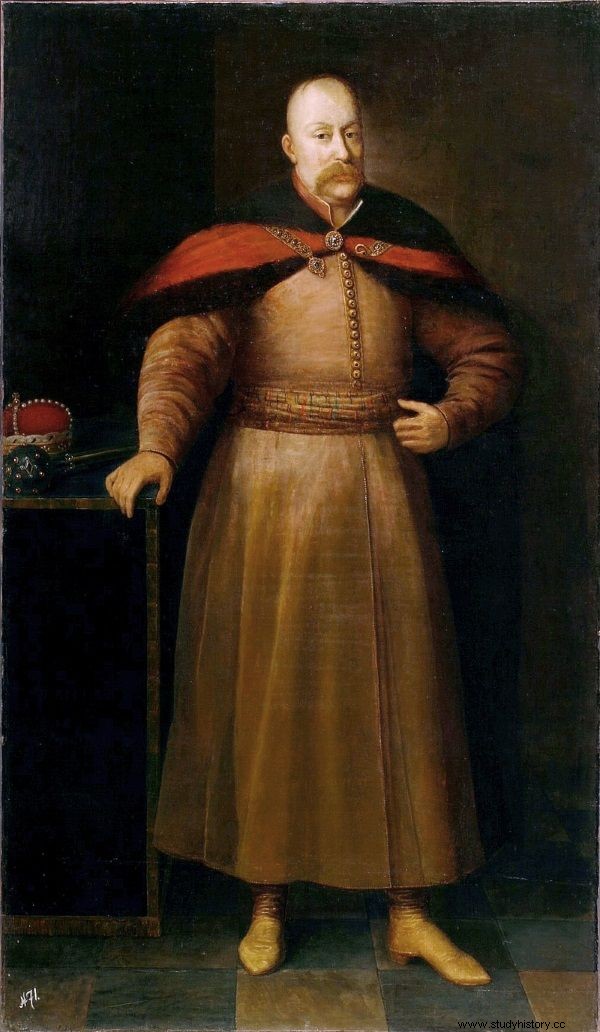
Was it Janusz Radziwiłł who betrayed him, or was it perhaps him and Lithuania who were betrayed?
Fighting two opponents at once was impossible in the long run. To make matters worse, the nobility in the Crown did not want to stop the Scandinavian invaders. The "gentlemen brothers" from Greater Poland surrendered to the Swedes, although they had one enemy army to stop. Radziwiłł had to choose the lesser evil. This is how he justified his decision in one of the letters:
Not for fame, not for the Republic of Poland, not for freedom and wealth, but for life. From the two evil ones we have to choose the lesser evil, we cry goodbye to our native freedom [...] we wrote a letter, they ask the Swedes for meals - because they do not use ordinary national rescue measures - protecting ourselves from Moscow tyranny as the worst evil of all.
The choice of the Swedes was a necessity, but word soon spread that the ambitious Radziwiłł had been planning such a step for a long time. In a letter to his cousin and associate Bogusław Radziwiłł, the Hetman did not hide his nervousness at the rumors. They say that I thought about it a long time ago, let the devil curse my soul if you ever put up with it in the past - he wrote.
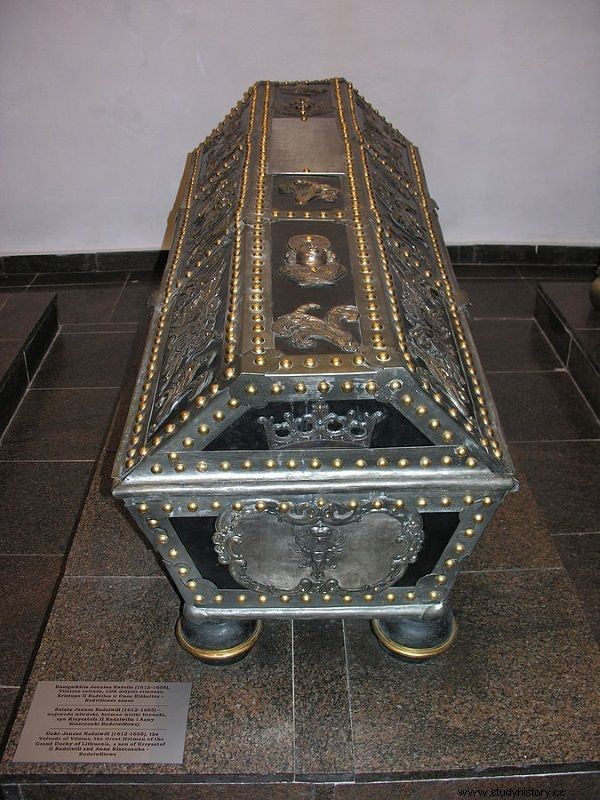
Radziwiłł, unlike many Polish lords, including Jan Sobieski, the later king of Jan III, did not manage to make a volts and return to the favor of the ruler. He did not live to see the end of the Flood. In the picture. Janusz Radziwiłł's tomb in the Evangelical Reformed Church in Kiejdany. (photos published under CCU 3.0 license, author:Bonio).
Why did Sienkiewicz omit this important thread? After all, taking into account the influence of Russian aggression on the hetman's attitude would be beneficial even from a literary point of view. The figure of Radziwiłł would gain additional depth. Unfortunately, the future Nobel Prize winner could not write much about the war with Moscow. When writing "The Trilogy", he lived in the Russian partition, where censorship was under surveillance.
Kmicic and Prince Bogusław Radziwiłł - not such enemies at all
Sienkiewicz, creating the figure of Andrzej Kmicic, the main character of "The Deluge", used several elements from the biography of the Orsha ensign, Samuel Kmicic. The prototype of the literary hero was a famous adventurer, but also a good soldier. He became famous during the fights with the Swedes and Moscow.
Unlike his literary incarnation, the historical Mr. Samuel did not consider Bogusław Radziwiłł as his number one enemy. True, they stayed in opposite camps. The political scene of the Grand Duchy of Lithuania was divided between the supporters of the Radziwiłłs and the supporters of the Sapieha families. Samuel Kmicic was with the latter. However, he must have remained on good terms with Prince Bogusław Radziwiłł himself.
The familiarity between them is indicated by the fact that Samuel Kmicic acted as an intermediary between Radziwiłł and Jan Kazimierz . In 1658, the Polish king tempted the prince with the return of confiscated properties in the event of the Swedish abandonment. Why was the Orsha ensign selected for this task? He had better relations with the prince than with other officers - suggests Marceli Kosman, author of the book "On the tracks of the heroes of the Trilogy".
Jealous historians
A literary work has its own rules. Sienkiewicz had to draw some things with a thicker line. Besides, it is not always easy to combine the fate of the fictional Oleńka Billewiczówna, Andrzej Kmicic and Mr. Zagboba with the historical Radziwiłł, Sapieha or Czarniecki. Therefore, "The Deluge" is not the most reliable source of historical knowledge. But does this mean that the author was inventing or creating a reality detached from historical sources? On the contrary!
Sienkiewicz's vision turned out to be so suggestive not only thanks to his literary talent. The author of "Trilogy" devoted a lot of time to researching sources and literature. He has read almost everything written about the mid-17th century! And although since his time - he wrote around 1884 - our knowledge of the times of the Swedish invasion has increased significantly, even today it happens that his technique prevails over criticized historians.
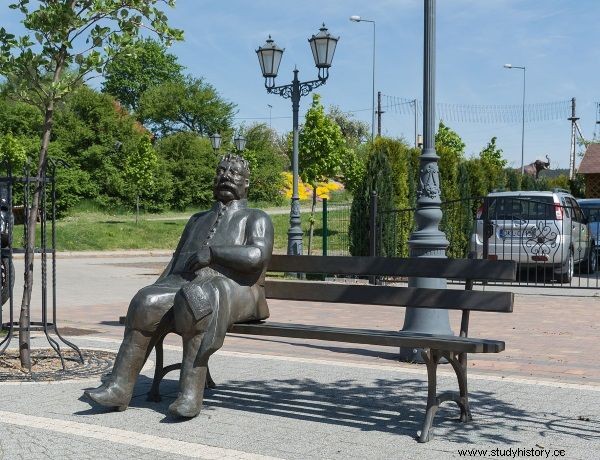
Although Mr. Zagłoba is only a literary figure, he is close to the hearts of Poles so much that they erected a monument for him in Szczytna. (photo published under the license of CCA SA 4.0, author:Jacek Halicki).
An example of Sienkiewicz's success from beyond the grave is the fighting scene in Warsaw, when Mr. Zagłoba is attacked in the Kazanowski Palace by ... monkeys . Suddenly he looked and noticed some bizarre monsters that were looking at him ominously from behind the bars of the iron cage - the great paragraph begins. Unfortunately, this episode was not included in Jerzy Hoffman's film. The argument of the operator Jerzy Wójcik contested. Do you want to show Zagłoba hacking poor animals with a saber? He asked.
Historians-scientists have been arguing for some time whether there were monkeys in the Kazanowski Palace in 1656 or not. Sienkiewicz was finally right.
